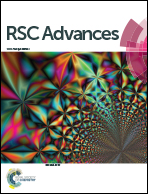One-step synthesis of peptide conjugated gold nanoclusters for the high expression of FGFR2 tumor targeting and imaging†
Abstract
An effective method to synthesize gold nanoclusters that can specifically recognize fibroblast growth factor receptor2 (FGFR2) was reported. We designed a new peptide sequence, cysteine–cysteine–tyrosine–leucine–glutamine–leucine–glutamine–alanine–glutamic–glutamic–arginine–NH2, and then used it as the precursor to synthesize red luminescent gold nanoclusters (GNCs) in one step. In order to better understand the properties of the GNCs, ultraviolet-visible spectra, transmission electron microscopy, Fourier transform infrared spectroscopy, X-ray photoelectron spectroscopy and matrix-assisted laser desorption/ionization time of flight mass spectrometry were used to characterize the GNCs. We also successfully applied the GNCs in fluorescence imaging of esophageal cancer KYSE510 cells that express in a high level of the FGFR2. The results demonstrated that the GNCs possess good luminescence, high stability, nontoxicity and good biocompatibility. We expect that the GNCs could find more applications in overexpression of the FGFR2 tumor cells imaging.


 Please wait while we load your content...
Please wait while we load your content...